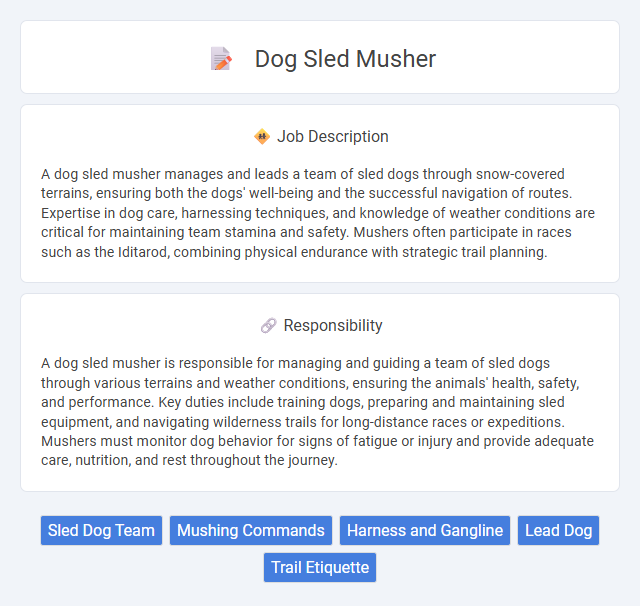
A dog sled musher manages and leads a team of sled dogs through snow-covered terrains, ensuring both the dogs' well-being and the successful navigation of routes. Expertise in dog care, harnessing techniques, and knowledge of weather conditions are critical for maintaining team stamina and safety. Mushers often participate in races such as the Iditarod, combining physical endurance with strategic trail planning.
People with strong physical endurance and a passion for outdoor adventure will likely be well-suited for a dog sled musher job, given the demanding conditions and long hours in harsh, cold environments. Those who thrive in remote settings and can handle unpredictable weather and challenging terrain probably have a higher chance of success. Conversely, individuals who prefer stable, indoor work or have limited tolerance for physical exertion and isolation might find this role less suitable.
Qualification
A dog sled musher requires strong knowledge of dog behavior, care, and handling techniques, often gained through hands-on experience with sled dogs. Physical endurance and survival skills in cold, challenging environments are essential for long-distance races or expeditions. Certification or training programs in animal welfare and first aid for both dogs and humans further enhance a musher's qualifications.
Responsibility
A dog sled musher is responsible for managing and guiding a team of sled dogs through various terrains and weather conditions, ensuring the animals' health, safety, and performance. Key duties include training dogs, preparing and maintaining sled equipment, and navigating wilderness trails for long-distance races or expeditions. Mushers must monitor dog behavior for signs of fatigue or injury and provide adequate care, nutrition, and rest throughout the journey.
Benefit
A dog sled musher job likely offers unique opportunities for physical activity and connection with nature, promoting both mental and physical well-being. Earnings may vary based on experience, location, and seasonal demand, with the potential for tips or sponsorships increasing income variability. The role probably fosters a strong sense of community and teamwork while providing a rewarding lifestyle for those passionate about animals and outdoor adventure.
Challenge
The role of a dog sled musher likely involves significant physical and mental challenges due to harsh weather conditions and the need for expert animal management. Navigating difficult terrain while ensuring the safety and coordination of the sled dogs probably requires high endurance and strong decision-making skills. Mushers may frequently face unpredictable situations that test their resilience and ability to adapt quickly.
Career Advancement
A dog sled musher can advance their career by gaining experience in competitive racing circuits such as the Iditarod or Yukon Quest, which enhances their reputation and attracts sponsorship opportunities. Mastering dog care, sled maintenance, and trail navigation contributes to becoming a sought-after guide for adventure tourism or expedition companies. Establishing a kennel and training programs also opens pathways to mentorship roles and business ownership in the dog sledding industry.
Key Terms
Sled Dog Team
A dog sled musher expertly manages a sled dog team, often consisting of 8 to 16 Alaskan Huskies or Malamutes, to navigate snow-covered trails efficiently. Mushers train their dogs in stamina, speed, and teamwork to optimize performance during long-distance races or expeditions. Effective musher skills include understanding canine behavior, maintaining sled equipment, and ensuring the health and nutrition of the sled dogs throughout arduous journeys.
Mushing Commands
Dog sled mushers rely on clear and specific mushing commands such as "Gee" to turn right, "Haw" to turn left, "Hike" or "Mush" to start moving, and "Whoa" to stop the team. Mastery of these vocal cues ensures effective communication and control over the sled dogs during races or excursions in snowy terrains. Precision in command execution is crucial for safety, coordination, and maintaining the sled team's rhythm.
Harness and Gangline
A dog sled musher expertly manages the harness and gangline systems to ensure optimal control and safety of the sled dogs during races or expeditions. The harness distributes pulling force evenly across each dog, while the gangline connects all dogs to the sled in a precise arrangement that maximizes teamwork and power. Mastery of these components is critical for efficient sled navigation and maintaining the dogs' health and performance in extreme conditions.
Lead Dog
A dog sled musher relies heavily on the lead dog to navigate trails and maintain pace during races or expeditions. The lead dog interprets commands, responds to environmental cues, and guides the entire team through challenging terrains like snow-covered forests or frozen tundras. Effective communication between the musher and the lead dog is essential for safety, speed, and successful completion of long-distance sledding events.
Trail Etiquette
Dog sled mushers must practice strict trail etiquette to ensure safety and respect for fellow sledders and wildlife. This includes signaling intentions clearly, maintaining proper spacing between sleds, and yielding to uphill traffic or overtaking teams safely. Understanding and adhering to these guidelines helps prevent accidents and preserves the integrity of the trail environment.
 kuljobs.com
kuljobs.com